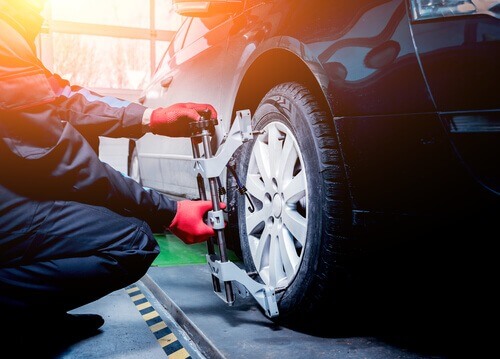Time for a car tyre check? Good on you for remembering. Keeping your tyres in good shape is essential.
You see, lack of proper maintenance, and general upkeep can actually result in some nasty incidents, flat tyres – or even collateral damage. With these helpful tyre safety tips, you can ensure your tyres are both safe to drive with and that your car is in the best possible condition.
Let’s do this!
Tyre pressure
Tyre pressure should always be your go-to when conducting a routine car tyre check. Driving with the right tyre pressure improves your safety on the road and improves your vehicle handling.
Oh, and it minimises the chances of a flat tyre. You should get in the habit of checking your tyre pressure once a month – or if your car does it electronically every now and then just in case the system’s down.
Here’s how to check and refill:
- Find out your car’s recommended tyre pressure. This information is available in your car’s manual – or sometimes in the fuel compartment.
- You can check your tyre pressure manually by plugging the refill air-hose available at most fuel stations, the initial reading you get will be your current pressure.
- To fill up – unscrew the valve cap and plug in the air compressor’s hose.
- Set the desired pressure level and press go until you hear the beep and disengage the hose.
- Always remember to screw the valve cap back on.
Tyre rotation

Tyre rotation is exactly what it sounds like. By rotating your tyres every 5,000 -10,000km (basically whenever it goes in for a service) you even out the wear and tear. This extends their life and improves the tread performance over the long term. This results in better cornering and braking – keeping you safe on the roads.
If you want to find out more about when to rotate your tyres contact our service team here at City Subaru, they’ll be happy to help.
Wheel alignment

Every time you drive, turn a corner, or rumble over a speed bump, you’re applying pressure to your wheel alignment. Over time, your wheels can become misaligned or jolted out of place during an accident. This can impact your vehicle’s handling and even become a safety issue in extreme circumstances.
We recommend getting a wheel re-alignment every 10,000km or at a minimum checked every time you get a service.
Tyre tread thickness
Your tyre tread thickness is literally how much rubber you’ve got left on your wheels. Legally, you’re required to have at least 1.5mm of tread. Anything below that and you’ll need to invest in some new tyres. You can check your tyre’s tread depth by looking at the indicator located on the tyre.
Tyre age

It’s not just driving every day that’ll wear out your tyres. Time will wear down your tyres and cause the rubber to crack or peel. That not only leaves your tyres exposed to punctures, it also impacts your car’s handling and safety. If a tyre is over 10 years old you should replace it no matter how it looks.
You can check the year the tyre was made by looking at the last 4 digits of the Serial Tyre Identification Number or (TIN). For example, 1015 would mean the 10th week of 2015.
Check the sidewalls
Checking your vehicle’s sidewalls is one of the more overlooked tyre safety tips, but no less important.
Sidewalls keep the air inside your tyre while holding up the weight of the car. They also help absorb shocks from bumps in the road. Check your sidewalls are free from damage such as cracks, bulges, dents or hints of oxidation or crumbling. Ensuring your tyres are at the right pressure is essential in ensuring your sidewalls are free from abnormal stress or wear and tear. If you notice any damage to your sidewalls, make sure you check in with a qualified auto-technician.
How to change a tyre

Did you know there’s a 30% chance that you (yes you) don’t know how to change a tyre? This vital skill won’t just get you out of a sticky situation – it could also save you from hours of waiting for roadside assistance.
Here’s how to do it:
- Make sure you’re parked in a safe area – out the way of moving traffic and ideally with a flat road surface. Keep the hand brake engaged.
- Take off the hubcap (if you have one) and use the wrench located (hopefully) in your car, loosen the nuts slightly.
- Place the car jack underneath the car close to the impacted wheel. Check your car manual to find the right spot.
- Jack up your car until the wheel is free to come off.
- Loosen the nuts until they come off, then carefully remove the wheel.
- Place the spare tyre on your wheel and screw the nuts back on, taking care to tighten them evenly.
- Lower the jack and replace the hubcaps. You’re good to go!
Drive carefully
As far as tyre safety tips go, your everyday driving habits are just as important as making sure your wheels are aligned and your pressure is sufficient. Reckless driving isn’t just illegal, it’s also bad for your tyres and can reduce your car’s performance on the road. Avoid sudden braking, or taking sharp corners at speed, as this will degrade your tyres and wheels faster. Remember road safety equals car safety.
ALWAYS pack a spare

Knowing how to change a tyre is no use if you don’t have a spare. Don’t put yourself in a situation where you can’t put those tyre-changing skills to work when they matter most. Do yourself a favour and pack a spare!
Is it about time you did some tyre maintenance? Get your tyres checked by professionals. Contact your local Subaru dealers. We’re ready to take your call.


